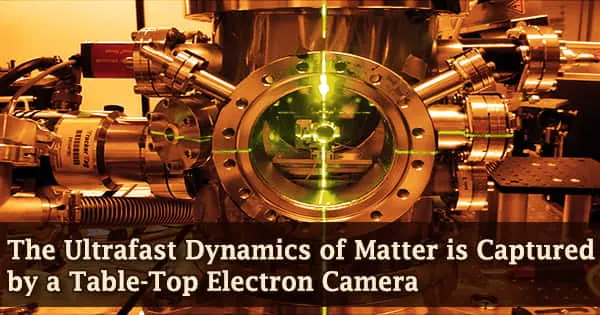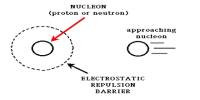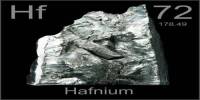DESY scientists have developed a small electron camera capable of capturing the inner, ultrafast movements of matter. The system fires short bursts of electrons at a sample to capture snapshots of its current inner structure, and it’s the first electron diffractometer to do so with Terahertz radiation.
The developer team, led by DESY scientists Dongfang Zhang and Franz Kärtner of the Center for Free-Electron Laser Science CFEL, validated their Terahertz-enhanced ultrafast electron diffractometer with a silicon sample investigation and published their findings in the first issue of Ultrafast Science, a new title in the Science group of scientific journals.
Electron diffraction is a technique for studying matter’s internal structure. It does not, however, directly photograph the structure. Instead, when electrons impact or traverse a solid sample, the electrons in the solid’s inner lattice deflect them in a systematic way.
The internal lattice structure of the material may be determined from the pattern of this diffraction, which is recorded on a detector. Short clusters of suitably luminous electrons must be employed to detect dynamic changes in this inner structure.
“The shorter the bunch, the faster the exposure time,” says Zhang, who is now a professor at Shanghai Jiao Tong University. “Typically, ultrafast electron diffraction (UED) uses bunch lengths, or exposure times, of some 100 femtoseconds, which is 0.1 trillionths of a second.”
State-of-the-art particle accelerators can consistently produce such brief electron bunches with high quality. However, due to the radiofrequency radiation utilized to power them, which operates in the Gigahertz band, these machines are frequently huge and heavy.
The size of the gadget is determined by the wavelength of the radiation. Instead, the DESY team is now using Terahertz radiation, which has wavelengths that are nearly a hundred times shorter.
“This basically means, the accelerator components, here a bunch compressor, can be a hundred times smaller, too,” explains Kärtner, who is also a professor and a member of the cluster of excellence “CUI: Advanced Imaging of Matter” at the University of Hamburg.
The scientists used a silicon crystal heated by a brief laser pulse to fire bunches of 10,000 electrons apiece as a proof-of-principle experiment. The bunches were roughly 180 femtoseconds long and clearly indicate how the silicon sample’s crystal lattice expands rapidly when the laser hits it within a picosecond (trillionths of a second).
The shorter the bunch, the faster the exposure time. Typically, ultrafast electron diffraction (UED) uses bunch lengths, or exposure times, of some 100 femtoseconds, which is 0.1 trillionths of a second.
Dongfang Zhang
“The behavior of silicon under these circumstances is very well known, and our measurements fit the expectation perfectly, validating our Terahertz device,” says Zhang. He estimates that in an optimized set-up, the electron bunches can be compressed to significantly less than 100 femtoseconds, allowing even faster snapshots.
On top of its reduced size, the Terahertz electron diffractometer has another advantage that might be even more important to researchers: “Our system is perfectly synchronized, since we are using just one laser for all steps: generating, manipulating, measuring and compressing the electron bunches, producing the Terahertz radiation and even heating the sample,” Kärtner explains. Synchronization is key in this kind of ultrafast experiment.
Researchers frequently repeat the experiment numerous times while delaying the measuring pulse a little more each time to examine the rapid structural changes within a sample of materials like silicon. The better the result, the more precisely this delay can be controlled.
The exciting laser pulse that initiates the experiment and the measuring pulse, in this case, the electron bunch, must usually be synchronized in some way. If the same laser triggers the commencement of the experiment as well as the electron bunch and its manipulation, synchronization is guaranteed.
The scientists intend to boost the energy of the electrons in the next step. Electrons with higher energy can penetrate thicker materials. The silicon sample had to be sliced down to a thickness of just 35 nanometres in the prototype setup, which utilized low-energy electrons (millionths of a millimeter).
According to the researchers, adding another acceleration stage could allow electrons to penetrate 30 times thicker samples with a thickness of up to 1 micrometer (thousandth of a millimeter).
X-rays are commonly utilized for even thicker samples. While X-ray diffraction is a well-known and often used technique, electrons normally do not do as much harm to the material as X-rays do.
“The energy deposited is much lower when using electrons,” explains Zhang. This could prove useful when investigating delicate materials.
This research was financed by the European Research Council’s Synergy Grant AXSIS (609920), the Deutsche Forschungsgemeinschaft’s Project KA908-12/1, and the Gordon and Betty Moore Foundation’s Accelerator on a Chip Program (ACHIP) (GBMF4744).
DESY is one of the world’s premier particle accelerator centers, studying everything from the interactions of small fundamental particles to the behavior of innovative nanomaterials and important biomolecules to the big mysteries of the universe.
The particle accelerators and detectors that DESY develops and builds at its locations in Hamburg and Zeuthen are unique research tools. They generate the most intense X-ray radiation in the world, accelerate particles to record energies, and open up new windows onto the universe.
DESY is a member of the Helmholtz Association, Germany’s largest scientific organization, and is funded 90% by the German Federal Ministry of Education and Research (BMBF) and 10% by the German federal states of Hamburg and Brandenburg (10 percent).















